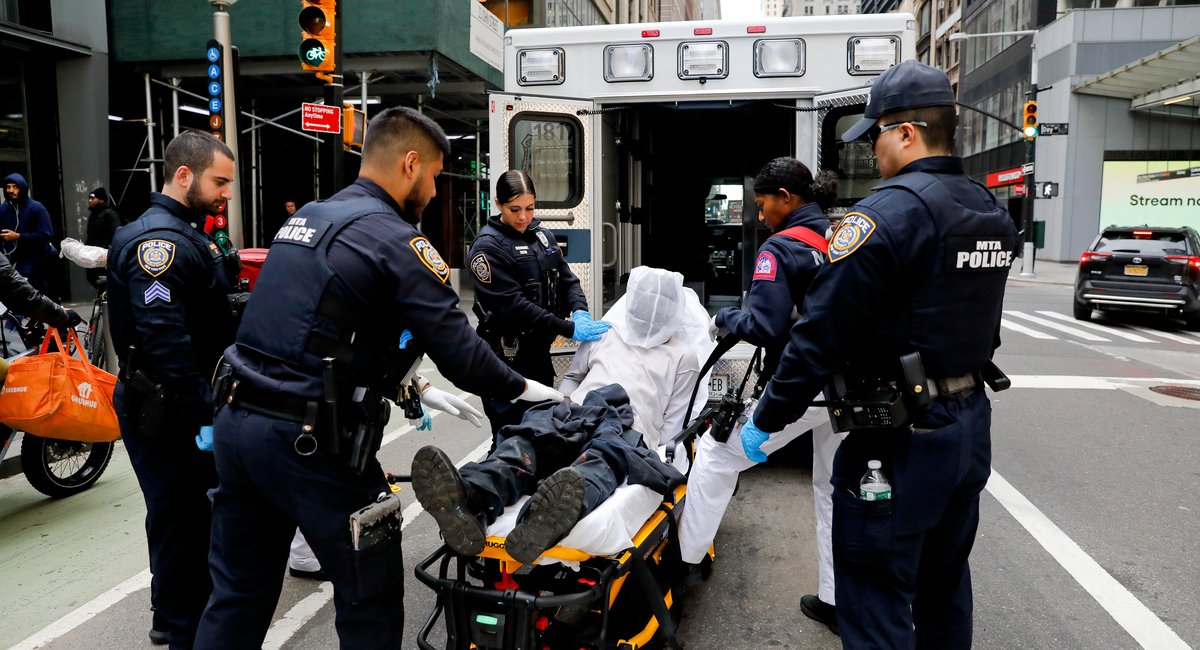As he watched EMTs forcibly load a disheveled, ranting man into an ambulance bound for Bellevue Hospital, clinician Ameed Ademolu – a different type of soldier in Gov. Kathy Hochul’s fight against subway crime – took notes.
While the National Guard is tasked with checking bags and creating a sense of security, Ademolu has the authority to invoke a “958.” That’s the code for someone to be taken to the hospital for a mental health evaluation against their will. Ademolu invoked that authority on Wednesday after determining the man at Fulton Transit Center was in the midst of a psychotic breakdown.
Hochul said unsettling confrontations like the one Gothamist observed while accompanying Ademolu and three MTA police officers on Wednesday need to occur more often. Ademolu and the cops make up one of only two SCOUT teams – short for subway co-response outreach – that seek out the most severely mentally ill homeless people in the system. The governor announced last week that she’ll spend $20 million to expand the initiative to 10 teams.
According to Hochul, the crews of cops and clinicians are key to maintaining order on the subway, where three murders have occurred this year, along with a shooting aboard an A train in Downtown Brooklyn on Thursday afternoon. Since the program launched roughly three months ago, SCOUT teams have sent 15 people to the hospital involuntarily for a psychiatric assessment. The MTA reports that most of these people have subsequently been admitted to psychiatric facilities. The teams have also sent 15 people to the hospital voluntarily and placed 45 people in shelters.
But the episode at Fulton Center – in which cops wrapped the man in a spit hood – highlighted the amount of resources required to forcibly get just one person evaluated. The MTA estimates there are 500 to 700 homeless people in need of mental health treatment in the transit system on a given day.
“We don’t have any uniform strategy to deal with any clients,” said Ademolu, 41. “We always do it one client at a time.”
Ademolu and the trio of MTA police officers headed to the Fulton Transit Center in the morning after an uneventful visit to the Whitehall Street-South Ferry station. Fulton Center is the system’s fifth-busiest station. But the real estate company operating retail there claims security is so poor that the MTA is breaching its 20-year lease agreement.
Ademolu approached a man laying on the ground near the uptown 4 and 5 trains. His clothes were dirty, and his smell filled the area. Ademolu slipped on a facemask and crouched close to him. After a brief conversation, the man gingerly stood up and hobbled away.
The man appeared in need of help. But by walking away and declining assistance without incident, he avoided an unwanted trip to the hospital.
“We’ll continue to look at his activities,” Ademolu told one of the police officers, adding that the man wasn’t sleeping and left on his own.
The job requires Ademolu make quick assessments of a suspected homeless person’s mental health. He studies their eye movements, their gait and their clothes. He mentioned one common indicator he looks for: an open wound. Hochul defined the people the SCOUT teams are looking for as individuals who obviously pose a risk to themselves or others.
Ademolu approached another homeless man just several minutes later, whose response soon resulted in more cops rushing to the scene.
The man had a long, disheveled gray beard. Snot dangled from his nostrils as he paced a corridor linking the A and C lines to the J train.
The man took off down the corridor after a brief exchange, shouting, “I’m taking the J train, leave me alone.” The MTA police officers moved in. Soon, there were a total of nine officers – both NYPD and MTA police – monitoring the confrontation as bystanders looked on, with some of them filming and others shouting at the cops.
Jeremy Feigelson, the former board chair of Partnership to End Homelessness, was among the observers. He has worked for the MTA for the last two years as a special counsel helping address homelessness in public transit.
“This guy, with the anger at this level, I think the indications are that we need a further assessment,” Feigelson said.
The homeless man continued yelling, “Leave me alone, I said don’t follow me.”
“You have to ask, is that person better off if he walks away and spends the day lurching around the subway system or is he better off if we spend a little more time with him and try and get him to help?” Feigelson said to a reporter.
But the homeless man didn’t have a choice. Ademolu decided it warranted a “958.”
Clinician Ameed Ademolu made the call that resulted in the homeless man at Fulton Transit Center being taken to Bellevue for an evaluation.
Stephen Nessen
Police put the man in handcuffs and took him outside. An officer grabbed the mesh spit hood and put it over his head.
“He has a ton of mucus coming down. It’s dripping into his mouth and as he’s talking, it’s going into some of the officers’ faces, and so that’s why we did that right there,” MTA Police Sgt. Steve Simmons said.
Ademolu stood off to the side and took notes on a clipboard.
“He was half-naked before,” Ademolu said, referring to the man’s sagging pants. “Acting erratic, he’s going through a psychotic breakdown right now.”
EMTs finally arrived after a half-hour, strapped the man to a wheelchair and loaded him into the ambulance. Ademolu rode in the ambulance and entered the hospital with him. He said he’d accompany the man through the admission process. State officials say the practice of having clinicians serve as familiar faces throughout the involuntary admissions process increases the chances of a positive outcome involving treatment, medication and housing. Other outreach teams are also working the subways, but are not dedicated to the most severe cases. A joint city and state homeless outreach effort, dubbed SOS, has helped 350 homeless people find stable housing since its launch two years ago, according to the governor.
The man seemed to have calmed down by the time Ademolu accompanied him into Bellevue. It was unclear if he’d been administered sedatives. The MTA declined to share the outcome of the forced visit due to patient confidentiality laws.
Many advocates for homeless people don’t believe this is the best approach.
“The evidence doesn’t necessarily suggest that you get better outcomes by involuntarily treating individuals,” said Will Watts, a deputy executive director at Coalition for the Homeless. “If there were low-barrier access to treatment to the appropriate facilities where individuals would be able to feel safe and stable then individuals will choose those options.”
Hochul insists the teams are a key tactic in her plan to “rid our subways of people who commit crimes.” Feigelson and the rest of the team will be out again on Monday.
“We’ll keep going until hopefully everyone who needs care gets it,” Feigelson said. “I think with enough resources and enough commitment, it can happen. That’s the goal.”


Leave a Reply